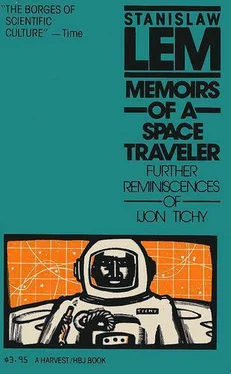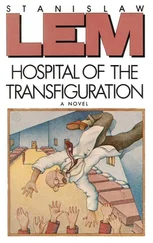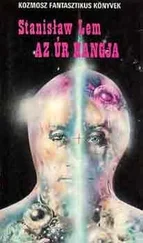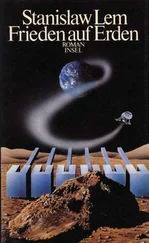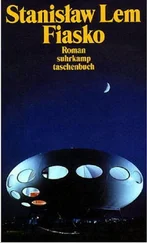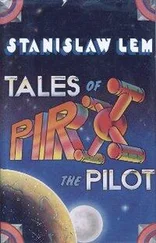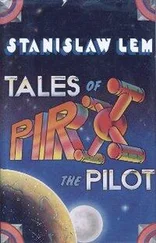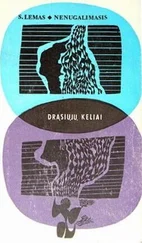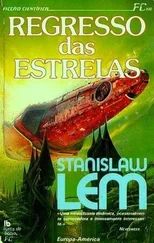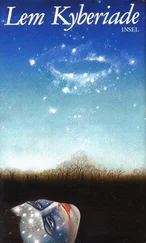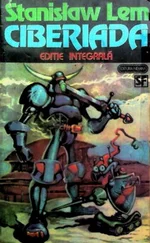In places famous for beautiful views one often sees comfortable wicker chairs that seem to invite the weary stroller. If he eagerly sits down between the arms, the supposed chair attacks, for it is actually thousands of spotted ants (the bottombiter chair ant, Multipodium psuedostellatum Trylopii ) that group together and mimic wicker furniture. Rumor has it that certain other varieties of arthropods (fripples, scrooches, and brutalacean rollipedes) have mimicked soda stands, hammocks, and even showers with faucets and towels, but I cannot vouch for the truth of such assertions, having myself seen nothing of the kind, and the myrmecological authorities are silent on this point. However, I should give a warning about a rather rare species, the snakefooted telescoper ( Anencephalus pseudoopticus tripedius Klaczkinensis ). The telescoper also stations itself in scenic spots, extending its three long, thin legs like a tripod and aiming its tubular tail at the scenery. With the saliva that fills its mouth opening, it imitates the lens of a telescope, enticing the careless tourist to take a peek, with extremely unpleasant consequences. Another snake, the trippersneak ( Serpens vitiosus Reichenmantlii ), found on the planet Gaurimachia, lurks in bushes and trips unwary passers-by with its tail. However, this reptile feeds exclusively on blondes and does not mimic anything.
The universe is not a playground, nor is biological evolution an idyll. We ought to publish brochures like those I saw on Derdimona, warning amateur botanists about the cruella ( Pliximiglaquia bombardons L .). The cruella has gorgeous flowers, but they must not be picked, because the plant lives in symbiosis with the brainbasher, a tree bearing fruit that is melon-sized and spiked. The careless botanizer need pluck only one flower, and a shower of rock-hard missiles will descend upon his head. Neither the cruella nor the brainbasher does any harm to the victim afterward; they are content with the natural consequences of his death, for it helps fertilize the surrounding soil.
But marvels of mimicry occur on all the planets in the Preserve. The savannas of Beluria, for example, abound with colorful flowers, among which there is a crimson rose of wondrous beauty and fragrance (the Rosa mendatrix Tichiana , as Professor Pingle named it, for I was the first to describe it). This flower is actually a growth on the tail of the herpeton, a Belurian predator. The hungry herpeton hides in a thicket, extending its extremely long tail far ahead, so that only the flower protrudes from the grass. When an unsuspecting tourist stoops to smell it, the beast pounces on him from behind. Its tusks are almost as long as an elephant’s. What a strange, extraterrestrial confirmation, this, of the adage that every rose has its thorns!
If I may digress a little, I cannot help recalling another Belurian marvel, a distant relative of the potato — the sentient gentian ( Gentiana sapiens suicidalis Pruck ). The name of this plant derives from certain of its mental properties. It has sweet and very tasty bulbs. As a result of mutation, the gentian will sometimes form tiny brains instead of the usual bulbs. This mutant variety, the crazy gentian ( Gentiana mentecapta ), becomes restless as it grows. It digs itself out, goes into the forest, and gives itself up to solitary meditation. It invariably reaches the conclusion that life is not worth living, and commits suicide.
The gentian is harmless to man, unlike another Belurian plant, the furiol. This species has adapted to an environment created by intolerable children. Such children, constantly running, pushing, and kicking whatever lies in their path, love to break the eggs of the spiny slothodile. The furiol produces fruits identical in form to these eggs. A child, thinking he has an egg in front of him, gives vent to his urge for destruction and smashes it with a kick. The spores contained in the pseudo-egg are released and enter his body. The infected child develops into an apparently normal individual, but before long an incurable malignant process sets in: cardplaying, drunkenness, and debauchery are the successive stages, followed by either death or a great career. I have often heard the opinion that furiols should be extirpated. Those who say this do not stop to think that children should be taught, instead, not to kick objects on foreign planets.
I am by nature an optimist and try to have faith in man, but it is not always easy. On Prostostenesa lives a small bird known as the scribblemock ( Graphomanus spasmaticus Essenbachii ), the counterpart of the terrestrial parrot, except that it writes instead of talks. Often, alas, it writes on fences the obscenities it picks up from tourists from Earth. Some people deliberately infuriate this bird by taunting it with spelling errors. The creature then begins eating everything in sight. They feed it ginger, raisins, pepper, and yellwort, an herb that lets out a long scream at sunrise (it is sometimes used as an alarm clock). When the bird dies of overeating, they barbecue it. The species is now threatened with extinction, for every tourist who comes to Prostostenesa looks forward to a meal of roast scribblemock, reputed to be a great delicacy.
Some people believe that it is all right if humans eat creatures from other planets, but when the reverse takes place they raise a hue and cry, call for military assistance, demand punitive expeditions, etc. Yet it is anthropomorphic nonsense to accuse extraterrestrial flora or fauna of treachery. If the deadly deceptorite, which looks like a rotten tree stump, stands posing on its hind legs to mimic a signpost along a mountain trail, leads hikers astray, and devours them when they fall into a chasm — if, I say, the deceptorite does this, it is only because the rangers in the Preserve do not maintain the road signs. The paint peels off the signs, which causes them to rot and resemble that animal. Any other creature, in its place, would do the same.
The famous mirages of Stredogentsia owe their existence solely to man’s vicious inclinations. At one time chillips grew on the planet in great numbers, and warmstrels were hardly ever found. Now the latter have multiplied incredibly. Above thickets of them, the air, heated artificially and diffracted, gives rise to mirages of taverns, which have caused the death of many a traveler from Earth. It is said that the warmstrels are entirely to blame. Why, then, don’t their mirages mimic schools, libraries, or health clubs? Why do they always show places where intoxicating beverages are sold? The answer is simple. Because mutations are random, warmstrels at first created all sorts of mirages, but those that showed people libraries and adult-education classes starved to death, and only the tavern variety ( Thermomendax spirituosus halucinogenes of the family Anthropophagi) survived. This special adaptation of the warmstrel, brought about by man himself, is a powerful indictment of our vices.
Not long ago I was incensed by a letter to the editor in the Stredogentsia Echo . The writer demanded the removal of both the warmstrels and the solinthias, those magnificent trees that are the pride of every park. When their bark is cut, poisonous, blinding sap squirts out. The solinthia is the last Stredogentsian tree not carved from top to bottom with graffiti and initials — and now we are to get rid of it? A similar fate appears to threaten such valuable fauna as the vengerix, the maraudola, the morselone, and the electric howler. The latter, to protect itself and its offspring from the nerve-racking noise of countless tourist radios in the forest, has developed, through natural selection, the ability to cancel out particularly loud rock-and-roll music. The electrical organs of the howler emit superheterodyne waves, so this unusual creation of nature should be placed under protection at once.
Читать дальше
